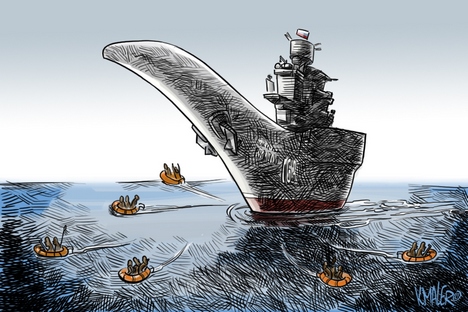
Click to enlarge the image. Drawing by Konstantin Maler
In recent years, it has become increasingly clear that the Russian Navy’s fleet, along with its aviation, has a crucial role in modern military conflicts. In this regard, the answer to the question about the class and type of warships that are needed by the Russian Navy today is of fundamental importance.
One of the most common types of armed confrontations today is the so-called asymmetric conflict, when there is a collision of the regular army with the irregular, for example, partisan or rebellious groups. The peculiarity lies in the fact that in this conflict between the strong and weak sides, the weak side departs from the “classical” rules of war.
In such military actions, which have become a reality of the 21st century, the aircraft carrier is extremely valuable. Unlike submarines, an aircraft carrier can support the landing of an observation group, and carry out the liberation of hostages or the landing of troops on the shore. With its deck-based aircraft, it can effectively control shipping lanes; it can protect from attacks or bombing from the air.
However, in the current armaments program for 2011-2020, no design and construction of a domestic aircraft carrier is included in Russia's defense plans. Instead, the main striking force is the nuclear submarines with their cruise missiles, which are also called nuclear underwater missile cruisers (NUMC).
The navy aircraft carrier program was thoroughly “shelved” in the Soviet and post-Soviet times. In the 1970s, Soviet leaders considered the aircraft carrier as a means of capitalist aggression and alien to the Soviet naval doctrine. Instead, the Soviet Union launched a program to build a heavy aircraft-carrying cruiser. Such hybrid of cruiser and aircraft carrier cannot be implemented, but it influenced the creation of aviation aircraft with vertical (shortened) takeoff and landing possibilities. British Aerospace was the only company that created a very successful model of such a vehicle – the Harrier. In the USSR, the “vertical takeoff” plane program suffered a complete failure. Moreover, the project was closed in 1991, after an incident that happened to the Yak-41 M. During testing, the Yak-41 M collapsed onto the deck of the aircraft carrier Admiral Gorshkov and burned up.
The other extreme of the aircraft carrier concept made itself felt in 2008, when Vladimir Masorin, Navy Admiral, commander at the time, proposed in the next 20 years to create six aircraft carrier battle groups. In his opinion, this was needed to bring Russia into second place, after the United States, relative to the strength of the surface fleet. If Russia had seriously participated in such a “competition,” this would have led to a military and economic collapse.
Russia has one aircraft carrier, built in 1982 at the Ukrainian shipyards in Nikolaev. This is the Riga aircraft carrier. It has at times been called the Leonid Brezhnev, Tbilisi, and from the autumn of 1990 – Admiral Kuznetsov. However, is this ship a real modern aircraft carrier? Hardly. First, it has a boiler-turbine power plant, which, unlike the nuclear one, significantly reduces the range of this ship. Second, it uses the bow ramp, instead of steam catapults for launching deck-based fighters. The catapult, according to experiments, ensures a safe takeoff of aircraft under all conditions, and reduces the dependence of the takeoff on the weight of the machine.
The main argument of the opponents of aircraft carriers is the idea that the carrier itself is not a weapon, as it needs aircraft and escort ships for protection. However, this argument is precisely the weakest. No modern ship, even the NUMC can be a “lone soldier in the field”. The Soviet Navy had a submarine orientation, but it was forced to create a surface fleet, and by 1991, this was composed of more than 100 ships of first and second ranks, which is more than enough for the creation of 15 aircraft carrier battle groups. In Russia there are about 30 such ships left today.
There will be no need to spend additional money on carrier aircraft. Russian naval aircraft are just modernized land versions. The T-50 of the fifth-generation, as it has been announced, will be made both in the “onshore” and deck designs. This means that they just need to reallocate the order for new planes by 2020 – to reduce the order of the “onshore” versions of the MiG-29, Su-35, and T-50, and increase the order for the naval aircraft.
With such a redistribution of resources, the “on-shore” Air Force will not be affected. The carrier-based aircraft can operate not only from the deck, but also from the airfield, unlike cruise missiles of the NUMC. And if there is any need, the carrier-based aircraft can be transferred to the coastal airfields. Thus, they will take orders from the Air Force, and will turn into a front-line aircraft.
Today, the Russian navy cannot resist Somali pirates or even protect its tourists from the “Arab Spring,” without such aircraft carriers.
All rights reserved by Rossiyskaya Gazeta.
Subscribe
to our newsletter!
Get the week's best stories straight to your inbox